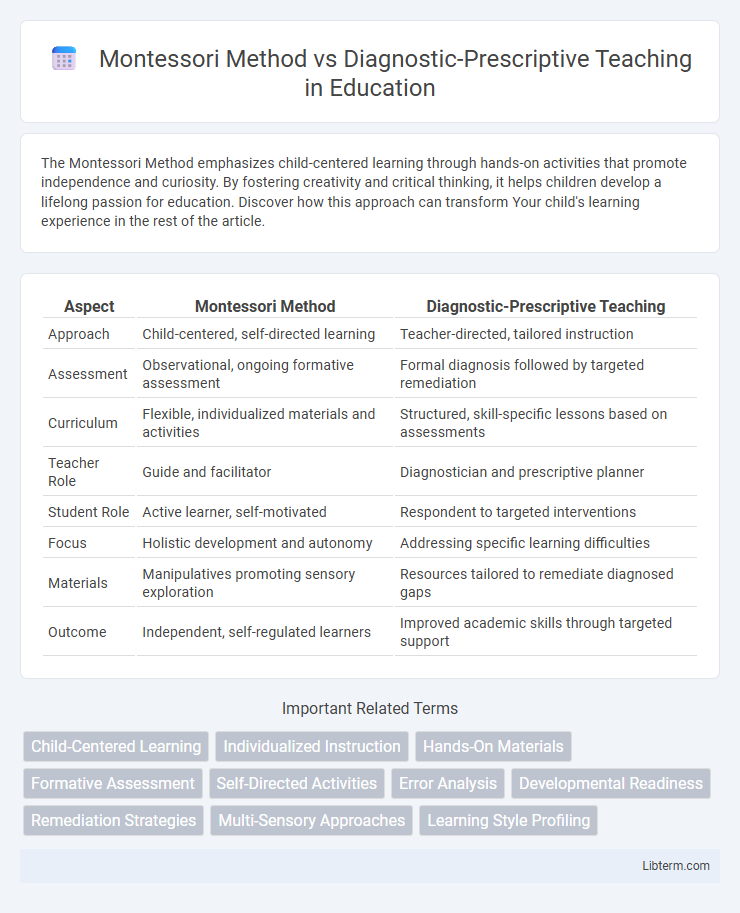The Montessori Method emphasizes child-centered learning through hands-on activities that promote independence and curiosity. By fostering creativity and critical thinking, it helps children develop a lifelong passion for education. Discover how this approach can transform Your child's learning experience in the rest of the article.
Table of Comparison
| Aspect | Montessori Method | Diagnostic-Prescriptive Teaching |
|---|---|---|
| Approach | Child-centered, self-directed learning | Teacher-directed, tailored instruction |
| Assessment | Observational, ongoing formative assessment | Formal diagnosis followed by targeted remediation |
| Curriculum | Flexible, individualized materials and activities | Structured, skill-specific lessons based on assessments |
| Teacher Role | Guide and facilitator | Diagnostician and prescriptive planner |
| Student Role | Active learner, self-motivated | Respondent to targeted interventions |
| Focus | Holistic development and autonomy | Addressing specific learning difficulties |
| Materials | Manipulatives promoting sensory exploration | Resources tailored to remediate diagnosed gaps |
| Outcome | Independent, self-regulated learners | Improved academic skills through targeted support |
Overview of Montessori Method
The Montessori Method is an educational approach developed by Dr. Maria Montessori that emphasizes child-centered, hands-on learning with self-directed activity and collaborative play. It utilizes specially designed materials to foster independence, sensory exploration, and natural development, allowing children to learn at their own pace in a prepared environment. The method promotes intrinsic motivation and holistic growth, contrasting with the Diagnostic-Prescriptive Teaching approach, which focuses on identifying learning difficulties and prescribing targeted interventions.
Understanding Diagnostic-Prescriptive Teaching
Diagnostic-Prescriptive Teaching emphasizes personalized instruction by assessing students' individual learning needs and prescribing targeted strategies to address specific weaknesses. This method relies on continuous evaluation and tailored interventions to optimize academic progress, contrasting with the Montessori Method's self-directed and exploratory learning approach. Effective implementation of Diagnostic-Prescriptive Teaching involves detailed diagnostic assessments, precise identification of learning gaps, and customized lesson plans designed to improve student outcomes efficiently.
Core Principles: Montessori vs Diagnostic-Prescriptive
The Montessori Method emphasizes child-led learning, sensory-based activities, and fostering independence through a prepared environment tailored to individual developmental stages. In contrast, Diagnostic-Prescriptive Teaching centers on identifying specific learning difficulties through assessment and then applying targeted interventions to address those gaps. Both approaches prioritize individualized learning but differ in methodology: Montessori relies on intrinsic motivation and self-correction, while Diagnostic-Prescriptive uses external evaluation and tailored remediation strategies.
Role of the Teacher in Each Method
In the Montessori Method, the teacher acts as a guide or facilitator, creating an enriched learning environment and allowing students to explore and learn independently at their own pace. In contrast, Diagnostic-Prescriptive Teaching requires the teacher to assess students' individual learning needs through diagnostic tests and then design targeted instructional strategies to address specific weaknesses. The Montessori approach emphasizes fostering autonomy and self-directed learning, while Diagnostic-Prescriptive Teaching prioritizes tailored interventions based on continuous evaluation.
Classroom Environment and Structure
The Montessori Method emphasizes a prepared classroom environment with child-sized furniture, accessible materials, and distinct learning zones that encourage independence and self-directed activity. In contrast, Diagnostic-Prescriptive Teaching relies on a structured classroom where the teacher continuously assesses students' individual learning needs to tailor specific instructional interventions. Both approaches prioritize student engagement, but Montessori spaces foster exploration while diagnostic-prescriptive settings focus on targeted skill development through teacher-led guidance.
Curriculum Design and Flexibility
The Montessori Method emphasizes child-centered curriculum design, allowing individualized learning paths that foster autonomy and self-paced progression through hands-on activities. Diagnostic-Prescriptive Teaching relies on systematic assessment to identify student needs, followed by targeted instruction tailored to address specific learning gaps within a structured framework. Flexibility in Montessori stems from adapting the environment to each learner, whereas Diagnostic-Prescriptive Teaching adjusts content and pacing based on ongoing diagnostic feedback.
Student Assessment Approaches
The Montessori Method emphasizes observational assessment, allowing teachers to monitor student progress through hands-on activities and self-directed learning without formal tests. In contrast, Diagnostic-Prescriptive Teaching relies on systematic evaluation through standardized assessments to identify specific learning difficulties and tailor targeted interventions. This approach prioritizes data-driven diagnosis to develop individualized educational plans that address areas of weakness precisely.
Individualized Learning in Both Methods
The Montessori Method emphasizes individualized learning through self-directed activities, allowing students to progress at their own pace using specially designed materials that cater to various developmental stages. Diagnostic-Prescriptive Teaching involves continuous assessment to identify each learner's specific strengths and weaknesses, followed by tailored instructional strategies to address gaps and reinforce skills. Both approaches prioritize personalized education but differ in that Montessori fosters intrinsic motivation and autonomy, while Diagnostic-Prescriptive focuses on targeted remediation based on diagnostic evaluations.
Benefits and Challenges Compared
The Montessori Method fosters self-directed learning, promoting independence and hands-on exploration, which benefits student engagement and creativity, yet may challenge standardized assessment compatibility and structured curriculum goals. Diagnostic-Prescriptive Teaching emphasizes individualized remediation based on diagnostic assessment, enhancing targeted skill development but potentially limiting learner autonomy and intrinsic motivation. Both approaches offer distinct advantages: Montessori excels in nurturing holistic development, while Diagnostic-Prescriptive ensures focused academic intervention, each facing challenges balancing flexibility with educational standards.
Choosing the Right Method for Your Child
Choosing the right educational approach for your child involves evaluating their learning style and developmental needs, where the Montessori Method emphasizes self-directed activity and hands-on learning to foster independence and exploration. Diagnostic-Prescriptive Teaching prioritizes individualized assessment and tailored instruction to address specific learning challenges and optimize academic performance. Parents should consider factors such as their child's motivation, attention span, and need for structured guidance when deciding between these two methods.
Montessori Method Infographic

 libterm.com
libterm.com